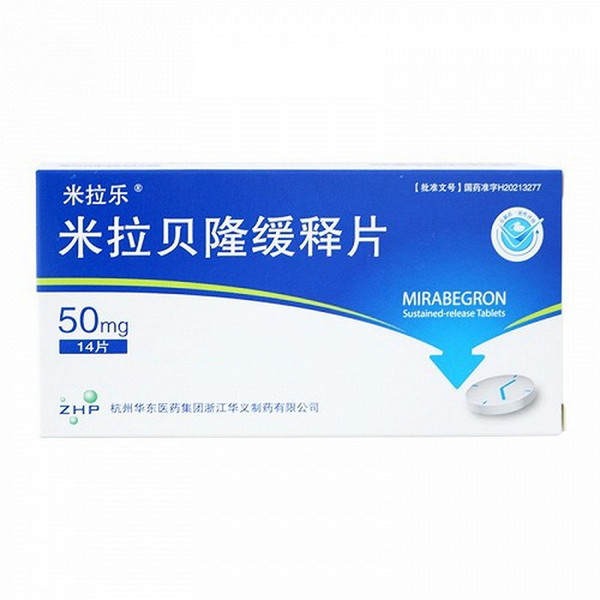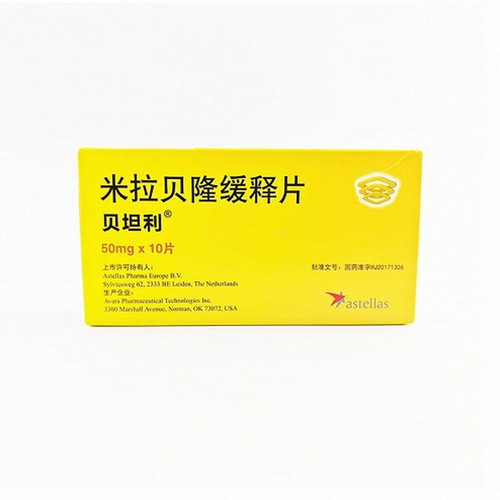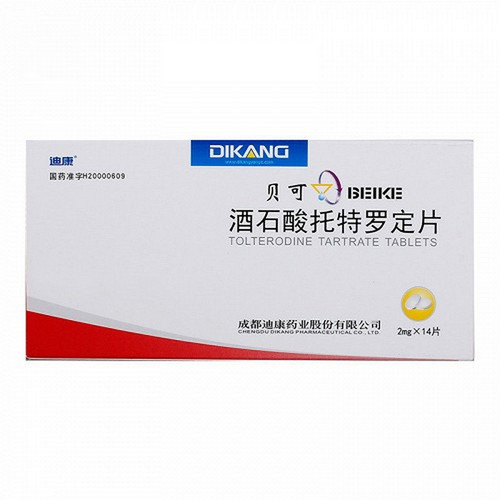Product Overview
[Drug Name]
Generic Name: Mirabegron Extended-Release Tablets
Trade Name: Mirale Mirabegron Extended-Release Tablets 50mg*14 Tablets
Pinyin Full Code: MilaLe MiLaBeiLongHuanShiPian 50mg*14 Tablets
[Main Ingredient]
Active ingredient: Mirabegron. Chemical name: 2-(2-amino-1,3-thiazol-4-yl)-N-[4-(2-{[(2R)-2-hydroxy-2-phenylethyl]amino}ethyl)phenyl]acetamide. Molecular formula: C₂₁H₂₄N₄O₂S. Molecular weight: 396.51
[Properties]
This product is a yellow film-coated tablet that appears white or off-white after removal of the coating.
[Indications/Main Functions]
Symptomatic treatment of urinary urgency, frequency, and/or urge incontinence in adult patients with overactive bladder (OAB).
[Specifications]
50mg*14 tablets
[Dosage and Administration]
The recommended dose for adults (including the elderly) is 50mg, taken once daily after meals. Take with water. Since this product is an extended-release tablet, it should be swallowed whole and not chewed, broken, or crushed. (See package insert for details.)
[Adverse Reactions]
See package insert for details.
[Contraindications]
Mirabegron is contraindicated in the following patients: - Hypersensitivity to mirabegron or any of the excipients of this product. - Patients with poorly controlled severe hypertension (systolic blood pressure ≥180 mmHg and/or diastolic blood pressure ≥110 mmHg).
[Precautions]
This product has not been studied in patients with end-stage renal disease (GFR <15 ml/min/1.73 m² or requiring hemodialysis). Therefore, this product is not recommended for these patients. There are limited data on the use of this drug in patients with severe renal impairment (GFR 15-29 ml/min/1.73 m²); based on the results of a pharmacokinetic study (see [Pharmacokinetics]), a dose reduction to 25 mg is recommended for these patients. Mirabegron is not recommended for patients with severe renal impairment (GFR 15-29 ml/min/1.73 m²) who are currently taking strong CYP3A inhibitors (see [Drug Interactions]). Mirabegron has not been studied in patients with severe hepatic impairment (Child-Pugh Class C), so its use is not recommended in this population. Mirabegron is not recommended for patients with moderate hepatic impairment (Child-Pugh Class B) who are currently taking strong CYP3A inhibitors (see [Drug Interactions]). Mirabegron may increase blood pressure in patients with hypertension; therefore, blood pressure should be monitored at baseline and periodically during treatment, particularly in patients with hypertension. Limited data are available for patients with moderate hypertension (systolic blood pressure ≥160 mmHg or diastolic blood pressure ≥100 mmHg). In clinical trials in patients with congenital or acquired QT prolongation, therapeutic doses of mirabegron did not cause clinically relevant QT prolongation (see [Pharmacology and Toxicology]). However, because these trials excluded patients with a known history of QT prolongation or those receiving medications known to prolong the QT interval, the effect of mirabegron on these patients is unknown. Caution should be exercised when using this product in these patients. In patients with bladder outlet obstruction and those taking antimuscarinic drugs for OAB, postmarketing experience with mirabegron has reported cases of urinary retention in patients with bladder outlet obstruction (BOO) and those taking antimuscarinic drugs for OAB. A controlled, safety clinical study did not demonstrate an increased risk of urinary retention in patients with BOO. Caution is recommended when using mirabegron in patients with clinically significant BOO. Mirabegron should also be used with caution in patients taking antimuscarinic drugs for OAB. Angioedema: Angioedema of the face, lips, tongue, and/or larynx has been reported following mirabegron administration. Some patients experience angioedema after the first dose, while isolated cases have reported angioedema occurring several hours after the first dose or after multiple doses. Upper airway swelling associated with angioedema can be fatal. If angioedema of the tongue, hypopharynx, or larynx occurs, mirabegron should be discontinued immediately and appropriate treatment should be instituted to ensure airway patency. In patients receiving CYP2D6-metabolized medications, since mirabegron is a moderate inhibitor of CYP2D6, systemic exposure of CYP2D6 substrates such as metoprolol and desipramine is increased when mirabegron is coadministered. Therefore, appropriate monitoring and dose adjustments are necessary, particularly when coadministered with medications with a narrow therapeutic index that are metabolized by CYP2D6, such as thioridazine, flecainide, and propafenone.








